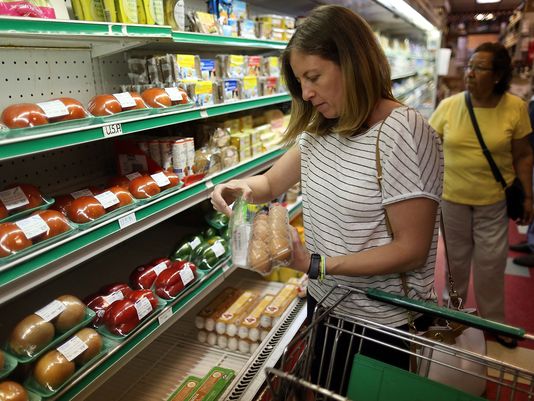With gas prices below $2 per gallon — about half of what they were less than two years ago — many are feeling a little relief at the pump. At the grocery store, however, the price of basic food items such as eggs, meat, and bread have all increased by at least 40% in recent years, despite tame national inflation.
![635917522318804378-groceries.jpg [image : 80766490]](http://cdn.tegna-tv.com/media/2016/02/22/WTSP/WTSP/635917522318804378-groceries.jpg)
Nationwide, food prices, as measured by the Consumer Price Index (CPI), increased 31.5% from 2005 through 2015, faster than general inflation over that period. The price of eggs more than doubled over the period reviewed, by far the largest increase of any grocery item. Using data from the Bureau of Labor Statistics (BLS), 24/7 Wall St. examined consumer price changes from 2005 through 2015 for more than 300 goods and services. These are the grocery items driving up your bill the most.
Sickness and disease of livestock are the primary reasons for many food price increases. An avian flu outbreak in August 2015 forced farmers to kill millions of egg-laying chickens, contributing to the 110% increase in the price of eggs in the 11 years through 2015. Similarly, a porcine epidemic diarrhea virus swept through the hog industry in 2013 and 2014, killing millions of pigs. Perhaps as a consequence, prices of bacon and sausage increased by 34.5%, and hot dog prices rose by 43.5%.
Particularly dry or extremely rainy seasons in food growing regions can also have a significant impact on consumer food prices. For example, grain such as wheat is highly susceptible to flooding that can occur in Plains states where most of the U.S. crop is grown.
Rising food prices not only increase Americans' grocery bills, but also can impact restaurants, which could be forced to amend portion sizes or entire menus to stave off shrinking margins. Restaurants may even decide to fire workers, forcing some service industry workers to contend not only with higher food prices, but unemployment as well.
To determine the grocery items driving up your bill the most, 24/7 Wall St., reviewed consumer price indices from 2005 through 2015 for over 300 goods from the Bureau of Labor Statistics (BLS). Definitions for each food category also came from the BLS.
These are the groceries driving up your bill the most.
1. Eggs
Eggs had by far the largest increase in consumer prices from 2005 through 2015, with prices increasing more than 110%. Prices peaked in August 2015 after an avian flu outbreak forced farmers to kill millions of egg-laying chickens. Even before the outbreak, the price of eggs had increased more than any food item. Still, egg prices fell 13.8% from their August high.
2. Tobacco and smoking products
Consumer prices of tobacco and smoking products — including cigarettes, cigars, smokeless tobacco and some e-cigarettes, among other products — have soared 92% from 2005 through 2015, nearly triple the average price increase of all grocery products. The largest price increase occurred in early 2009 when the federal tobacco tax increased by 62 cents to $1.01. Cigarette prices may rise even further. PresidentBarack Obama has proposed an additional 94 cent tax increase, though it has not garnered much support.
3. Margarine
Rising margarine prices have been largely driven by the supply and demand for butter, a close substitute. According to one estimate, an average American consumes nearly 6 pounds of butter each year, up from 5 pounds in 2010. International demand for butter and margarine has also grown as many developing countries expand their food service industry. Meanwhile, since the recession, many dairy farmers have gone out of business due to low milk prices and droughts in California. This has significantly restricted the supply of dairy products, causing a price increase in butter, which potentially forced would-be-butter-users towards margarine.
4. Uncooked ground beef
Consumer prices of uncooked ground beef increased by more than 65% from 2005 through 2015, more than double the increase in food prices generally. The price of all beef and veal products increased by 56.2% over the same period. Severe droughtthroughout the U.S. in 2012 led to a spike in corn prices, the primary feed grain of cows and other animals. This induced many cattle farmers to bring a larger share of their herd to market to avoid higher feeding costs and drove the total number of cattle in the country to 87.7 million, the lowest since 1951.
5. Shelf stable fish and seafood
Like many of the grocery items with rapidly increasing prices, both supply and demand factors have influenced the price of shelf stable fish and seafood, which includes canned fish. According to the USDA, certain fish species — such as tilapia, salmon, and many shellfish — face increased demand, particularly from China. As is the case in other food markets, rising feed costs have also contributed to the decline of fish populations such as tuna and shrimp.


